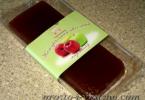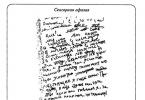Salon
Hello. We will replace the front brake pads on a Hyundai Tucson car. 2 Pads are changed when the lining thickness is less
millimeters. The condition of the pads should be checked once every 15 thousand kilometers.
Hyundai Tussan has wear indicators on the front pads. If the wear is critical, you will hear a squeaking sound when braking.
Step by step replacement
1. Remove the wheel.
2. Unscrew the lower guide bolt.

Unscrew and hold the guide pin from turning.
Open-end wrenches are needed for fourteen and seventeen.


3. Raise the caliper and remove the metal lining from the inner pad.


4. Remove the old inner and outer pads.
5. Remove the metal guide brackets for the pads. We clean the dirt underneath with a brush.
6. We recess the brake piston using plumbing pliers through the adapter. You can also buy a special one for this. tool.
7. Inspect the guide pins. Lubricate them, and if damaged, replace the anthers.
8. Install the guide brackets of the pads.
9. Install the inner and outer blocks. We only buy original pads.
10. Install the metal cover on the inner block.
11. Close the caliper and tighten the guide bolt.
14.06.2017
The pads are changed on the axle; you cannot change the pads on just one wheel. Replacing the front brake pads of a Hyundai Tucson is a procedure on the car maintenance list that should be performed approximately every 60 thousand kilometers. However, the actual frequency depends very much on the management style, prevailing road conditions , the quality of the pads themselves and much more. Some wash them even for 30 thousand, although there have been cases where original pads were used on Tussan with a mileage of under 100 thousand, but these, of course, are exceptions to the rule. This manual is suitable for crossovers produced in 2010-2014, designated ix-35, as well as for the next generation, produced since 2015. On many Hyundai and Kia cars the design brake system
When choosing pads, you need to remember that they catalog numbers may vary depending on the year of manufacture of the vehicle, its modification and the FWD/4WD/AWD drive system.
Disassembling the front brake caliper
We park the crossover on level ground and fix its wheels. wheel chocks to prevent rollback. Loosen the nuts a little on the wheel where you plan to replace the pads. To do this we use a wheel wrench. Raise the car using a jack.
Unscrew the nuts and remove the front wheel. This way we got access to the brake caliper, steering knuckle and front suspension parts.

Let's sort it out stopping support Hyundai Tucson
The front caliper is held in place by two bolts tightened with reverse side. We unscrew the upper and lower ones alternately with a 14 mm socket and a ratchet wrench, turning clockwise when looking from the outside of the car.
We remove the Tussan brake caliper with an outward movement and place it in such a way as not to damage it brake hose. Using a flat-head screwdriver, remove the old brake pads. We remember the position of the wear indicator so that if it is present on new pads, install them in the same way.
Installation of new pads and assembly
Before installing new front brake pads, it is advisable to clean the areas from dirt. In order for the brakes to operate easily and smoothly, the two caliper guides that are located inside the caliper must be lubricated. To do this you need to use graphite, copper grease or brake lubricant. If the new pads come with pressure springs, you need to replace them too.
We install new parts in the same way as the previous ones, paying attention to the position of the wear indicator. Since the thickness of new pads is much greater than worn ones, it may be necessary to recess the piston brake cylinder so that they can fall into place. To do this, you will need a special device, which can be purchased at a car store. It can be useful for repairing and servicing brakes not only on Tussan. If there is no slide for the brake cylinders, you can push it down by placing it on a hard surface and pulling it towards you. In this case, care must be taken not to damage its boot, brake hose and other parts.

Changing the front brake pads
We install the pads in their places and put the brake caliper back. Before installing the guides, lubricate them. If rubber boots If they are torn or damaged, they also need to be replaced, otherwise dirt and water will get into the caliper and it can quickly fail. Such boots are usually sold as part of a custom caliper repair kit.
Tighten the bolts. Install the wheel.
After replacing the brake pads, be sure to check the level brake fluid. The container with it is located under the hood closer to windshield. Since we recessed the cylinder piston, the level may be higher than normal. If this is the case, some of it needs to be pumped out using a syringe. If the level, on the contrary, is below normal, the fluid must be added.
After installing new pads, it is recommended to drive quietly for some time, without sudden braking, to allow them to get used to the brake discs. The grip of the brakes may seem weak at first, but it should recover after some time. If this does not happen or you feel jerking and vibration when braking, you should have the brake system diagnosed with the help of professionals. May need to be replaced brake discs or other parts thereof.
If there are scuffs, deep scratches and other defects on the working surface of the disc that increase pad wear and reduce braking efficiency, as well as in the case of increased lateral runout of the disc, causing vibrations during braking, replace the disc. In specialized workshops, such a disk can be machined and ground on both sides to the same depth, but after processing, the thickness of the disk must be no less than the minimum permissible.
Minimum permissible thickness of the brake disc of the brake mechanism front wheel- 24.4 mm. If one of the discs is less than the specified thickness, replace both discs. When replacing brake discs Be sure to replace the brake pads with a new set.
You will need: Phillips screwdriver, wheel nut wrench.
1. Remove the wheel from the side of the disc being replaced.
2. Remove the caliper assembly (see “Replacing the front wheel brake caliper assembly with the pad guide”) without disconnecting the brake hose, and secure with wire, avoiding twisting or tension on the hose.

3. Remove the two screws securing the disk to the hub... 
4. ...and remove the disk.
5. Similarly, remove the brake disc of the brake mechanism of the other front wheel.
6. Install the parts in the reverse order of removal.
Note
Before installing the disc, thoroughly clean the mating surfaces of the hub and disc from rust and scale, since even the smallest particle sandwiched between the mating surfaces will cause the disc to run out and vibrate during braking.
Helpful advice
If you are installing an old disk, use a file to remove the beads on the working surfaces of the disk that have formed as a result of wear on both sides of the disk.
Jambs:
1) When unscrewing the caliper mounting bolts, you need to hold the caliper pins with a wrench to prevent them from turning. If they still don’t turn, congratulations, they’ve turned sour. Read about them below. We tie the caliper itself on the hose with a piece of wire to one of the coils of the spring shock absorber strut. It doesn’t interfere there and definitely won’t fall and break the hose.
2) The caliper bracket that is attached to the suspension knuckle does not need to be unscrewed by hitting it with a hammer. Take the head, a good wrench and an extension to it, and the lower bolt will come out just fine, if not with the force of your hand, then with the force of your foot. The top bolt can be unscrewed with a normal star wrench, hard, but almost immediately. If it’s a little difficult and you don’t want to strain, again a head with a knob and a pipe, only a pipe that will fit under the wing. The bolts are on a thread lock, just like the bolts of the caliper itself. You need to put them back on it and tighten it with the specified torques, and not at random. The tightening force for the bracket bolts is higher, but the caliper bolts do not pull very hard at all; many people overtighten and then have problems with them. The tightening torques are described in the repair documentation.
3) It is necessary to check whether the fingers of the caliper brackets have become sour. If it has turned sour, it means the bracket does not move and does not press the outer pad when braking, only the inner one is braked, the one that is pressed by the cylinder piston. It is usually erased to zero, but the outer one is almost not worn out. The fingers need to be knocked out and lubricated with brake lubricant, and not with Lithol, for example, as some do.
4) When the M6 screws securing the disk are removed, there is no need to hit the disk with a hammer with all your might, just tap it with inside in several places around the circumference, these are not oak Zhigulis, here everything is installed with normal fits, and does not rust permanently.
We drill out the screws that cannot be unscrewed by any force. First we drill out the cap to remove the disc. After soaking the remaining stumps, we try to unscrew them. If it doesn't work, we'll drill it out. First, use a smaller drill, then bring it to a diameter of 5.6 mm and then use an M6 tap to carefully clean the threads in the hub from the remainder of the screw.
5) You can put the disk on one screw, but at least there should be one. The author apparently has never changed a wheel with a loose brake disc on the road. I took off the wheel, and the disk shifted once, then I installed the wheel, and the disk stuck in place. And everything’s like okay, let’s go.
5) The assembly process described by the author is nonsense. This is the normal process. The surface for installing the disk is cleaned thoroughly. The brake disc is installed. The caliper bracket is installed. The same pieces of hardware from the pads are inserted into it, which are actually the locking springs of the pads. The pads are inserted, first the inner one, then the outer one. Before installation, check to see if the pads are dirty oily hands, if yes, degrease. We install the caliper, before doing this we recess the cylinder. If you previously filled the brake fluid to the upper mark, it will flow out of the tank, so you need to suck it out a little with a syringe. Installed the caliper. We check the rotation of the disk - remove it from gear, first making sure that the car does not roll. Inspecting the disc for stains lubricants. Degrease with solvent. Believe me, if there is even a small amount of oily rubbish on the pads or disc, they will not slow down.
6) Install the wheel. Start the engine and work the brake pedal vigorously to select the pad clearances. You can do this without installing the wheel, the main thing is that the car stands securely - it does not fall or roll. Then it will be possible to immediately assess whether the pads move away from the disc normally, releasing it.
At the end, we look at the brake fluid level and top up as needed.
Proper replacement of the front pads with cleaning of the parts takes no more than an hour. Without any f...nul, uh...chil, etc.
Hyundai Tucson.
Front wheel brakes
Hyundai Tucson. Replacing the brake pads of the front wheel brake mechanism »).
Check the condition of the brake pads at every service (see "
Note
Checking the degree of wear of brake pads and discs
Brake pads require replacement when the linings are worn (the minimum permissible thickness of the friction linings is 2.0 mm), the linings are not firmly connected to the base, the working surfaces are oily, or there are deep grooves or chips.
Replace front brake pads only as a set - 4 pcs. (two on each side).
Before replacing brake pads, check the fluid level in the master cylinder reservoir. If it is close to the “MAX” mark, it is necessary to pump out some of the liquid (for example, with a medical syringe or a rubber bulb), because after replacing the worn pads with new ones, the level will rise.
You will need: wrenches “14”, “17”, a wrench for wheel nuts, sliding pliers.
1. Remove the left front wheel.
2. Remove the bolt securing the lower guide caliper pin, holding your finger from turning with the second key...
3. ...and lift the caliper up.
4. Remove the inner pad trim...
5. ...internal...
6. ...and outer brake pads.
Note
This is what the brake pads of the front brake mechanism look like: 1 - internal and external brake pads; 2 - internal brake pad lining; 3 - brake pad wear indicator.
7. Remove the lower...
8. ...and the upper fixing springs.
9. Press the piston of the working cylinder using sliding pliers.
Useful tips
Each time the brake pads are replaced mandatory check the condition of the protective rubber covers guide pin and movement of the caliper relative to the brake pad guide. If movement is difficult, lubricate grease
caliper guide pins. For this...
...remove the guide pin, lubricate it with grease and then lubricate the protective cover of the pin with grease. Similarly, lubricate the second guide pin and its cover. Install the guide pins in the reverse order of removal. Replace protective covers
guide pins if they are hardened, deformed or torn.
10. Install the retaining springs, brake pads in the guides and other parts in the reverse order of removal. To prevent self-turning of the caliper guide pin fastening bolt, lubricate its threads with an anaerobic thread locker before installation.
11. Replace the brake pads of the right front wheel in the same way.



